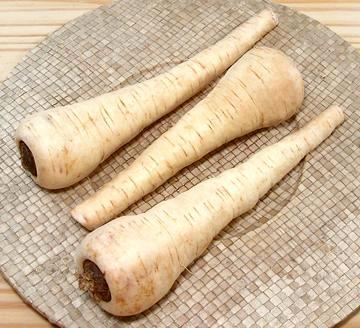 [Pastinaca sativa]
[Pastinaca sativa]
Native to Eurasia, parsnips have been eaten since ancient times and were carried north by the Romans who found they grew much larger in colder climates. They are harvested after the first sharp frost as their flavor improves from this exposure. They are not grown in frost free climates for this reason. In recent times parsnips have been overshadowed by the potato but are still featured in some European traditional meals. Today they are often used to flavor soups and stews. Parsnips are less crisp, sweeter and milder but more aromatic in flavor than carrots. The front photo specimen was 9-3/4 inches long, 2-3/8 inches diameter and weighed 8-7/8 ounces.
Wild parsnips should be avoided as their foliage contain a chemical that sensitize the skin to sunlight resulting in severe burns. They are also easy to confuse with Hemlock, an extremely deadly relative.
More on Parsleys
In Europe they were a major starchy root vegetable until arrival of the potato and still play an important part in some traditional meals. They were commonly roasted, often along with meat, but also steamed or boiled and mashed.
Today parsnips are most used as an aromatic vegetable in soups and stews. The should be added near the end of cooking or they will become mushy - they aren't nearly as durable as carrots.
py_parsnz 081218 - www.clovegarden.com